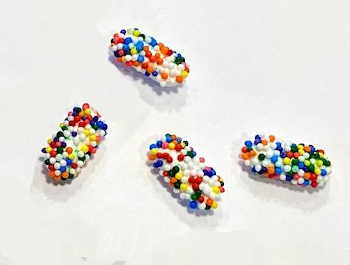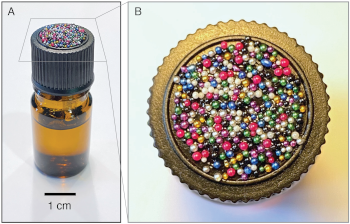Product Authentication
June 27, 2022
in the late
2000s, I worked on a project to create an unique
anti-counterfeiting labeling system for
product packaging.
Counterfeit pharmaceutical products are a serious problem in
low- and middle- income countries. A 2018 study found the prevalence of
substandard and
falsified medicines in such countries to be 13.6%, with the highest prevalence in
Africa (18.7%) and
Asia (13.7%).[1-2] The reasons for this are simple. Counterfeit pharmaceutical products are very
profitable, about as profitable as
narcotics with lower
risk, and countries in the
developing world have inadequate
regulation and
enforcement.

In the United States, we're generally well protected from counterfeit pharmaceuticals by the Food and Drug Administration. However, some people purchase prescription drugs through online pharmacies, whose sources are problematic.
Of course, the root cause for this is the fact that drug prices in the United States are nearly four times higher than those of similar countries.
(Background, a Wikimedia Commons image by Pöllö.)
Techniques from anti-counterfeit measures for
paper currency have been applied to packaging, as listed here.
Serial numbers - Serial numbers were the first protection measure used for paper currency, and these added an additional step beyond just printing. Today, serialization can be much more complex with the use of multi-dimensional barcodes which can be imaged by a smartphone and checked on a manufacturer's website. Combined with GPS, it can be determined whether the point of sale is a logical point in the supply chain, and it can report the locale of probable counterfeit sales.
Holograms - Holograms affixed to packages are an effective deterrent to counterfeiting, since 3D holograms are difficult to manufacture.
Inks and Dyes - Fluorescent inks will emit light at specific wavelengths when exposed to ultraviolet light. Different inks can be used at different locations on the package. Alternatively, a luminescent topcoat can be applied to show colors and patterns under ultraviolet illumination.
RFID - Radio frequency identification devices (RFID) are slightly more expensive than the other listed anti-counterfeiting measures, but their computing capability gives access to cryptographic and blockchain techniques that cannot be duplicated.
These methods can be applied to pharmaceutical packaging, but what about their contents? While minimal printing can be applied to the surfaces of pills, tablets, and capsules, this isn't an effective anti-counterfeiting method.
William H. Grover, an
associate professor in the
University of California, Riverside, Department of Bioengineering, found a novel method of
coding these pharmaceutical items. He
glues small, multicolored
candy nonpareils to the pill or tablet surface to create a unique code for each, and the method can be used for packaging as well.[3-4] One advantage of this technique is that it labels the medication, itself, and not the packaging.
Pharmacies often dispense medicines in
generic containers, so a
rogue pharmacist could dispense fraudulent medication in such containers.[3] His
research is
published in a recent issue of
Science Reports.[3]

Pharmaceutical caplets coated with candy nonpareils.
One problem with this method is the principle that you should never tell your children that drugs are "candy."
Pharmaceuticals processed this way should be contained in child-resistant containers.
(Portion of a University of California, Riverside, image by William H. Grover.[4])
Grover writes that counterfeit or substandard medicines cost an estimated $200 billion dollars
annually; and that the
World Health Organization estimates that one in ten medical products in developing countries are fake.[3-4] His idea for this
invention, which he calls CandyCode, came about during the
COVID-19 pandemic shutdown.[4] The nonpareils are tiny, inexpensive, multi-color candy
spheres that are added to
cakes, candies, and similar
edibles as
decorations.[3] Says Grover,
"The inspiration for this came from the little colorful chocolate candies. Each candy has an average of 92 nonpareils attached randomly, and the nonpareils have eight different colors. I started wondering how many different patterns of colored nonpareils were possible on these candies... It turns out that the odds of a randomly generated candy pattern ever repeating itself are basically zero, so each of these candies is unique and will never be duplicated by chance."[4]
Consumers could
photograph a medication with a smartphone, upload the photograph to the manufacturer's
website, and find whether the medication is genuine or fraudulent.[4]
There has been
prior research on using random
physical patterns as unique identifiers. In one study, a
laser transmitted through a
transparent matrix containing small
glass particles, randomly
distributed, produces a unique
optical speckle pattern.[5] Random patterns of
molecules,
nanotubes,
nanoparticles, and other objects have also been proposed.[6] As for edible objects, fluorescent
silk microparticles, produced by
genetically-engineered silkworms, can be distributed randomly in a thin silk film that can be glued to a medication.[7] This technique, however, requires
specialized equipment such as
fluorescence microscopes that are not used by consumers.
Nonpareils applied at random to a medication form a pattern with an extreme unlikelihood of ever being repeated.[3] In his
experiments, Grover coated
Tylenol® capsules with nonpareils and developed an
algorithm that converts a photograph of a such a CandyCoded pill into a
text string identifier that can be used for
database query, and he verified that his process was robust against physical
damage, such as what might occur in
shipping.[4] The system would allow 10
17 code
combinations; or, 41 million for
each person on Earth.[3-4] This technique can be applied also to
bottle caps (see photo),[4] although glass or
plastic beads would be a better choice for such an application.

A CandyCoded lid for a perfume bottle.
(University of California, Riverside image by William H. Grover, licensed under a Creative Commons Attribution 4.0 International License. Click for larger image.)
References:
- Organisation for Economic Cooperation and Development (OECD), "Mapping the scale of the fake pharmaceutical challenge
OECD/EUIPO (2020), Trade in Counterfeit Pharmaceutical Products, Illicit Trade," OECD Publishing (Paris), https://doi.org/10.1787/a7c7e054-en.
- Sachiko Ozawa, Daniel R. Evans, Sophia Bessias, Deson G. Haynie, Tatenda T. Yemeke, Sarah K. Laing, and James E. Herrington, "Prevalence and estimated economic burden of substandard and falsified medicines in low-and middle-income countries: A systematic review and meta-analysis", JAMA Network Open, vol. 1, no. 4 (2018), pp.e181662-e181662, doi:10.1001/jamanetworkopen.2018.1662. This is an open access article with a PDF file here.
- William H. Grover, "CandyCodes: simple universally unique edible identifiers for confirming the authenticity of pharmaceuticals," Scientific Reports vol. 12 (May 6, 2022), Article no. 7452, https://doi.org/10.1038/s41598-022-11234-4. This is an open access article with a PDF file here.
- Holly Ober, "Candy-coated pills could prevent pharmaceutical fraud," University of California, Riverside, Press Release, May 6, 2022.
- Ravikanth Pappu, Ben Recht, Jason Taylor, and Neil Gershenfeld, "Physical one-way functions," Science vol. 297, no. 5589 (September 20, 2002), pp. 2026-2030, DOI: 10.1126/science.1074376.
- Riikka Arppe and Thomas Just Sørensen, "Physical unclonable functions generated through chemical methods for anti-counterfeiting," Nature Rev. Chem., vol. 1, no. 4 (April 5, 2017), pp. 1-13, https://doi.org/10.1038/s41570-017-0031.
- Jung Woo Leem, Min Seok Kim, Seung Ho Choi, Seong-Ryul Kim, Seong-Wan Kim, Young Min Song, Robert J. Young, and Young L. Kim, "Edible unclonable functions. Nat. Commun., vol. 11, no. 1 (January 16, 2020), Artical no. 328,https://doi.org/10.1038/s41467-019-14066-5. This is an open access article with a PDF file here.
Linked Keywords: 2000s; counterfeit; anti-counterfeiting; labeling; product packaging; pharmaceutical drug; developing country; low- and middle- income country; standardization; substandard; fake; falsified; medicine; Africa; Asia; profit (accounting); profitable; narcotics; risk; developing world; regulatory agency; regulation; law enforcement agency; enforcement; United States; protection; protected; Food and Drug Administration; prescription drug; online pharmacy; root cause; prescription drug prices in the United States; GDP; similar country; Wikimedia Commons; Pöllö; technology; technique; banknote; paper currency; serial number; printing; dimension; multi-dimensional; barcode; digital imaging; image; smartphone; manufacturing; manufacturer; website; Global Positioning System (GPS); point of sale; logic; logical; supply chain; locale (geographic); sale; holography; hologram; deterrent; three-dimensional space; 3D; ink; dye; fluorescence; fluorescent; emission spectrum">emit light; wavelength; ultraviolet light; luminescence; luminescent; topcoat; color; pattern; radio frequency identification devices (RFID); cost; expensive; computing; cryptography; cryptographic; blockchain; William H. Grover; associate professor; University of California, Riverside, Department of Bioengineering; code; coding; adhesive; glue; candy nonpareils; pharmacy (shop); pharmacies; trademark; generic; container; rogue; pharmacist; research; scientific literature; publish; Science Reports; caplet; coating; coated; child; children; candy; contained; child-resistant packaging; year; annual; World Health Organization; approximation; estimate; invention; COVID-19 pandemic shutdown; sphere; cake; edible; decorative art; decoration; inspiration; chocolate; randomness; random; odds; chance; consumer; website; prior art; prior research; physics; physical; laser; transmittance; transmitted; transparency; transparent; composite material; matrix; glass; particles; dispersion (chemistry); distributed; optics; optical; speckle pattern; molecule; nanotube; nanoparticle; silk; microparticle; genetically modified organism (GMO); Bombyx mori; silkworm; laboratory equipment; specialized equipment; fluorescence microscope; experiment; Tylenol (brand); Tylenol®; algorithm; string (computer science); text string; database; query language; query; damage; freight transport; shipping; combination; world population; each person on Earth; bottle cap; plastic; bead; Creative Commons Attribution 4.0 International License.